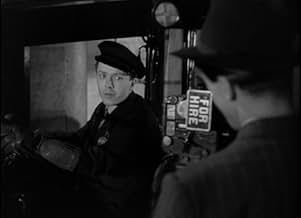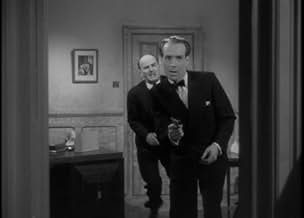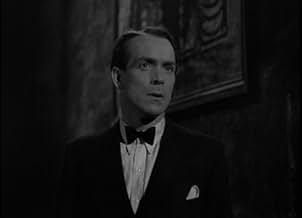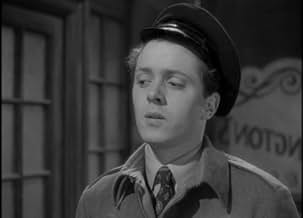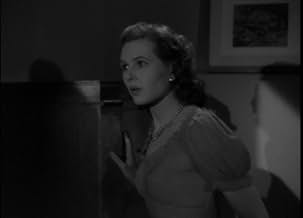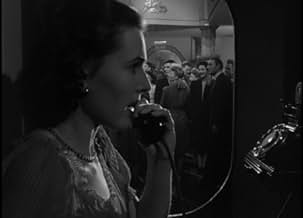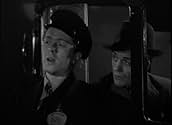Ajouter une intrigue dans votre langueA London cab driver gets mixed up with a criminal gang and sets out to expose the group and its leader for what they are.A London cab driver gets mixed up with a criminal gang and sets out to expose the group and its leader for what they are.A London cab driver gets mixed up with a criminal gang and sets out to expose the group and its leader for what they are.
- Réalisation
- Scénario
- Casting principal
Bill Owen
- Dave Robinson
- (as Bill Rowbotham)
Dirk Bogarde
- Policeman
- (non crédité)
Patricia Dainton
- Pam
- (non crédité)
Diana Dors
- Annette
- (non crédité)
Richard Duke
- Palais-de-Danse Customer
- (non crédité)
Danny Green
- Sid
- (non crédité)
Chris Halward
- Miss Brown
- (non crédité)
Joy Harington
- Friendly Barmaid
- (non crédité)
Jack Mandeville
- Palais-de-Danse Customer
- (non crédité)
Avis à la une
Brisk, efficient British post-War crime melodrama set in London - part of the 'Spiv' movie cycle(films with roots in 30s American Gangster movies, featuring characters profiting from wartime rationing in a similar fashion to 30s bootleggers, but not so clearly glamorised as their Stateside equivalents - see also the superior NOOSE). Richard Attenborough stars as former soldier, Ted Peters, now making a living as a London cab-driver who becomes involved with a criminal gang headed by dance hall owner and criminal mastermind Mr Gregory (the seriously undervalued Barry Jones), whose henchman and M.C. Paul Baker (Barry K. Barnes) has offed Ted's childhood friend and former army buddy Dave Robinson (Bill Rowbotham, better known to U.K. audiences as Bill Owen, star of long-running U.K. T.V comedy series LAST OF THE SUMMER WINE). At Ted's behest, his girlfriend Joy (Sheila Sim) gets a job as a dancehall hostess in Gregory's dance hall as part of Ted's attempts to expose the criminal gang and the true nature of the crime lord's enterprise is gradually exposed. Punchily directed by John Paddy Carstairs, and redolent with post-War atmosphere, this is another example of the type of popular genre fare which entertained U.K. audiences in the 40s at the same time as the now revered 'noir' movies similarly engaged their U.S. contemporaries. Deserving wider acclaim, the movies from this post-War U.K. genre are valid, and diverting, social documents which often gave early exposure to burgeoning talents (in this instance, an uncredited brunette Diana Dors and a 'blink and you'll miss him' Dirk Bogarde) and should, by rights, be as revered in their country of origin as the more celebrated and documented U.S. post-War crime movies. Worth checking out, if you get the chance.
Not really the best title for this ordinary British crime-noir, but Richard Attenborough ("Ted") and Shiela Sim ("Joy") put in a decent effort. He is a London taxi driver who finds himself embroiled in some criminal activities when his wartime friend is found murdered. The trail leads both him and the police to a nightclub run by "Gregory" (Barry Jones) and his MC "Baker" (Barry K. Barnes). The pair decide that "Joy" may be able to help their investigation by taking a job as an hostess at the club, but is she putting herself and him in even more danger as the gang soon realise that they are onto them? This packs quite a bit into eighty minutes and both at the top of the bill do their jobs efficiently - as does the under-stated Jones. The ending is a bit weakly predictable and it rather dialogue heavy, but it's still quite a watchable afternoon feature with a bit of menace, a little humour and a fine collection of hats!
Worth it for the post-war background. The 50s "New Look" hadn't happened yet and all the girls have big hair and big shoulders - much more flattering than the 50s fashions that made everyone look middle-aged.
Richard Attenborough and Sheila Sim are likeable. They get involved in investigating the murder of their friend, a young, dashing Bill Owen.
It's a shame Diana Dors wasn't credited. She was good in her early roles - she turns up in another dance hall with Petula Clark and Bonar Colleano. I think she was dubbed in both films, though.
To the gentleman who thought it terribly rude that some other bloke could just grab your partner - it was called an "excuse me" dance. There was also a "ladies excuse me". This is not a regular Palais de Dance, however - the girls are all professional hostesses.
Richard Attenborough and Sheila Sim are likeable. They get involved in investigating the murder of their friend, a young, dashing Bill Owen.
It's a shame Diana Dors wasn't credited. She was good in her early roles - she turns up in another dance hall with Petula Clark and Bonar Colleano. I think she was dubbed in both films, though.
To the gentleman who thought it terribly rude that some other bloke could just grab your partner - it was called an "excuse me" dance. There was also a "ladies excuse me". This is not a regular Palais de Dance, however - the girls are all professional hostesses.
Compo from "Last of the Summer Wine" obviously loved the East End and probably made friends with Chas 'n' Dave. That's why I saw them play at Holmfirth. It was where Summer Wine was filmed – the friendship link is complete. Compo is an East end gangster in this film. He's short in stature and makes an unconvincing tough guy. He would have been flattened in his fight scene at the beginning of the film. The same goes for his ex-army buddy, Richard Attenborough (Ted), Again, this short person would have been flattened in both his fight scenes. The fights are badly staged and very fake.
There's a criminal gang running a dancehall and carrying out robberies and Dickie short-arse meddles in their affairs so he can get to the truth behind his pal Compo's demise. Guess what – he succeeds. Standard good guy v bad guy stuff. The most interesting moments of the film for me occur in the dancehall where Diana Dors hangs out. Singer and dancehall girl Judy Kelly (Toni) is the best of the cast. What is it with people cutting in on other men dancing with a girl by tapping them on the shoulder and stealing their girl away? No way! This would be disastrous and cause non-stop scuffling. I hear this was an American custom introduced in films. I can't believe this actually happened! Any info on this ludicrous concept would be greatly appreciated.
There's a criminal gang running a dancehall and carrying out robberies and Dickie short-arse meddles in their affairs so he can get to the truth behind his pal Compo's demise. Guess what – he succeeds. Standard good guy v bad guy stuff. The most interesting moments of the film for me occur in the dancehall where Diana Dors hangs out. Singer and dancehall girl Judy Kelly (Toni) is the best of the cast. What is it with people cutting in on other men dancing with a girl by tapping them on the shoulder and stealing their girl away? No way! This would be disastrous and cause non-stop scuffling. I hear this was an American custom introduced in films. I can't believe this actually happened! Any info on this ludicrous concept would be greatly appreciated.
Not much mystery here as the crime and perpetrator is known from the start so more of a how-will-they-catch-him than a who-dunnit. Still, there is charm in the setting: a dancehall where girls work to dance with patrons serves as a cover for the HQ of the local kingpin: an aristocratic yet particularly wily chap, who seems to smuggle gin and trade in 'surplus' goods, among other things. Innocents get swept up in the milieu and, though painted as too goody-goody, have a close brush with both the criminal and police world which toughens them up a bit. Barry K. Barnes plays the kingpin's chief henchman and delivers a subtle psychopathic gentleman killer vibe. There is some nice framing here and there, plus you get 1947 London, and its various pubs and characters , which helps sustain the film through its lulls (here and there), and the ending has its own minor twists. Other little highlights are scenes with Richard Attenborough and Diana Dors. I can't say it held my full attention 100% throughout but I am not regretful about having seen it - just 83 mins long! It's an alright movie if you are looking for a quite gentle noir in an unusual setting and a little but not too much excitement.
Le saviez-vous
- AnecdotesSir Richard Attenborough (Ted Peters) and Sheila Sim (Joy Goodall) were married in real-life.
- GaffesIn the ballroom scene at the start of the film the shadow of the camera is clearly visible on the clothing of the dancers as it pans past them.
- Citations
Inspector Carter: Peters, did you turn in your revolver when you were demobbed?
Ted Peters: Yes sir.
Inspector Carter: Good. It's a pity all the boys didn't do that - it would've saved them a lot of trouble. And us.
- Bandes originalesBow Bells are London Bells
Lyric of the Song by Harold Purcell
Music by Benjamin Frankel (as Ben Bernard) (uncredited)
Meilleurs choix
Connectez-vous pour évaluer et suivre la liste de favoris afin de recevoir des recommandations personnalisées
- How long is Dancing with Crime?Alimenté par Alexa
Détails
- Date de sortie
- Pays d’origine
- Langue
- Aussi connu sous le nom de
- Dansand cu crima
- Lieux de tournage
- Cromwell Studios, Southall, Middlesex, Angleterre, Royaume-Uni(studio: produced at Cromwell Studios, Southall)
- Sociétés de production
- Voir plus de crédits d'entreprise sur IMDbPro
- Durée1 heure 23 minutes
- Couleur
- Rapport de forme
- 1.37 : 1
Contribuer à cette page
Suggérer une modification ou ajouter du contenu manquant

Lacune principale
By what name was Dancing with Crime (1947) officially released in India in English?
Répondre

